×
Don't miss out!
Sign up for 10% off your first order
and exclusive product previews!
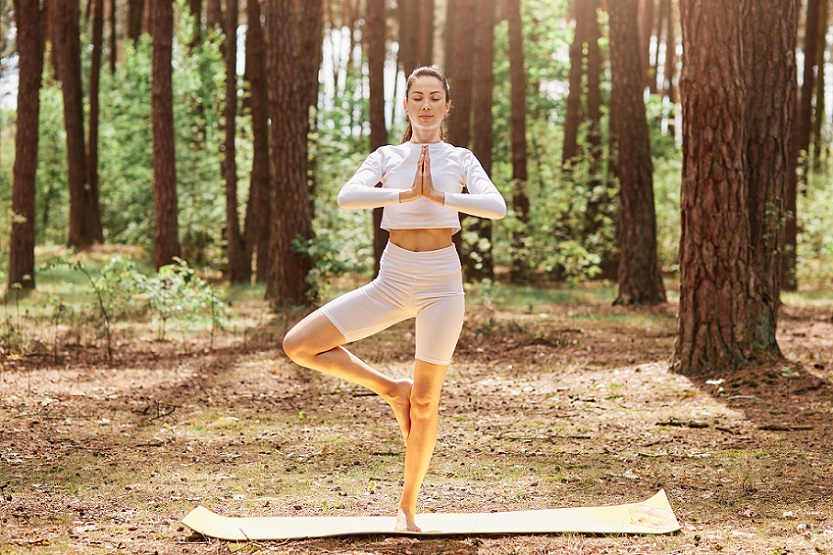
Some studies have even indicated that certain amounts of caffeine intake plays a role in increasing stress levels, or bouts of insomnia in adults.
Yoga on the other hand, actually has been proven to help provide better sleeping patterns and quality. It may help with lowering blood pressure, reducing anxiety levels, and a better overall mood.
If you’re not already a yoga enthusiasts, you may not have a clue what it is, and how it can benefit you.
To be quite honest, we certainly cannot cover everything yoga is and the benefits in just one post. However, we can cover some basics, benefits and get you started with a few “energy -geared” asanas.
The practice of yoga is large, and continues to grow in popularity, as numbers have reached 36 million in 2016. Imagine where the numbers stand up to in the present moment? Yoga has dozens (probably over 100) different subsets or types within it. One of the benefits of this, is that there is most likely a “type” of yoga for everyone and anyone. For example, from beginners, to advanced, the elderly, and kids. There are even classes and poses couples can do together, called couples yoga!
Oftentimes, the main components comprising this practice include; focused breathing, meditation, and assuming specific postures.
What in the world can yoga do for your energy levels, you may be asking?
In general, yoga is a practice, that when done regularly can have a positive impact on mental health and well-being. Specifically, helping create a sense of clarity, calmness, sharpen concentration, and increase body awareness. In addition, allowing you to have an outlet for helping to deal with life’s day-to-day struggles.
According to John Hopkins Medicine, yoga can give you a mental and physical energy boost, and experience fewer negative emotions. As a matter of fact, studies have also indicated that acute bouts of yoga, like hatha yoga, benefit executive function and mood to some degree.
Yoga International describes the energy yoga gives, slightly different, adding that yoga is a way to “turn on the tap” and “remove blockages of the flow”. They discuss the ability of yoga to open up channels within the body, called meridians, to help with the flow of energy.
With this all being said, let’s get into some poses.
If you want to learn more about how you can incorporate yoga into your everyday life, here are a few poses you can use, to utilize yoga for energy.
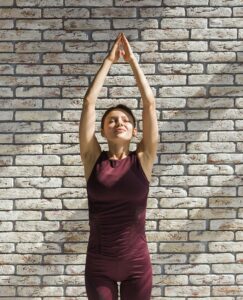
The first pose in this sequence of energy-boosting yoga postures is upward salute. Urdhva Hastasana is a beginner pose done in the standing position, and is a great stretch-type asana, working the arms, shoulders, neck and back.
Steps:
1. Firstly, to perform this pose, stand tall and evenly on your feet, hands beginning at the side of your body.
2. Then, with the palms facing away from your body to start, begin to raise them upward, keeping your back straight, not hunching over.
3. While raising your arms, you should also ensure that you are taking a slow, deep inhale, focusing on your breathing!
4. As you raise, you can either keep your arms parallel to one-another or continue to touch palms and interlock your fingers. Try to stretch your arms and fingertips high above your head.
5. Extend your arms with your elbows, tilting your head ever so slightly backwards, as to gaze up towards your hands.
6. You can further this asana by leaning to the right and/or left side. Hold for 30 seconds, or 5-breathing cycles
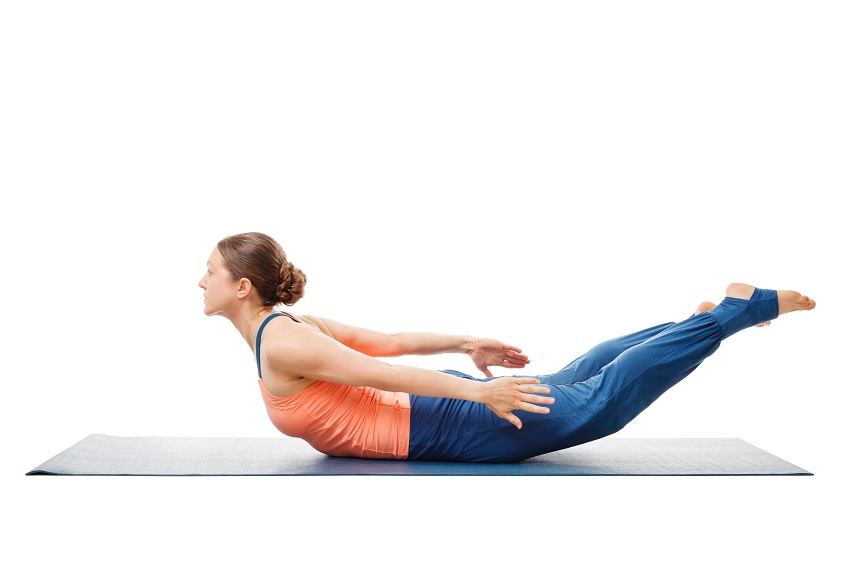
One of the key ways you can use yoga for energy is by stretching parts of your body that normally are tight and don’t get a lot of activity throughout the day. This is where Salabhasana comes in as a great little energy booster.
Another beginner pose, locust asana is done in the prone position and is a back-bend, stretch-type, maneuver.
Salabhasana can benefit your lower and upper back, chest, core, hamstrings, and neck.
Steps:
1. Firstly, it’s helpful to have a yoga mat for comfort while lying in the prone position. Alternatively, you could also use a yoga blanket.
2. Lye on the floor on your belly. Initially your arms will be out to the side, palms facing up on the mat, roughly at a 45 degree angle with your torso.
3. Begin to tighten your buttock, exhale, pressing the pubic bone down into the floor and then begin to lift your legs, torso, head, and arms off the mat, arching your back.
4. Then, as you continue this stretch, imagine your scapula’s pressing down into your back.
5. Also, try and reach with your fingertips and toes in each direction, continuing with your controlled breath.
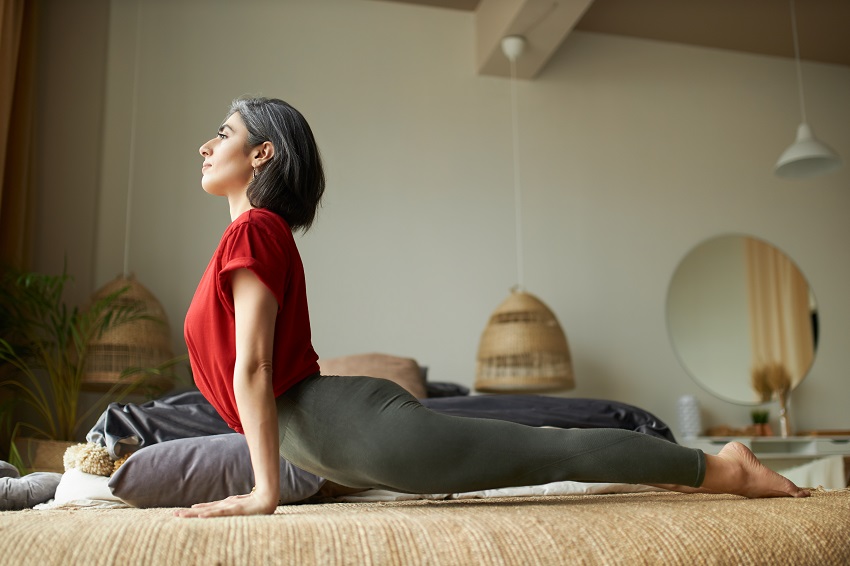
This is a great yoga pose to transition to, from the locust pose. A beginner-intermediate pose, performed in the prone position. Like the locust pose, Urdhva Mukha Svanasana is a stretch, back-bend type asana.
Benefiting the arms, shoulders, middle and lower back, as well as the chest, core, neck, legs and pelvis region, this is truly a full-body strength and stretch position.
Steps:
1. If you’re coming out of the locust pose, drop the legs, hips, upper torso and head back down to the mat, lying on your belly.
2. Place your hands by your shoulders on each side, exhale, begin pressing the palms into the ground. Extend your arms/elbows straight.
3. Lift your thighs off the mat with the aide of the tops of your feet, as you continue to press your palms into the mat.
4. Then, gently press your chest forward, and begin to stretch your neck, the crown of your head up towards the ceiling. This is similar to the cobra pose.
5. Continue with controlled breathing for about 3-5 breath cycles
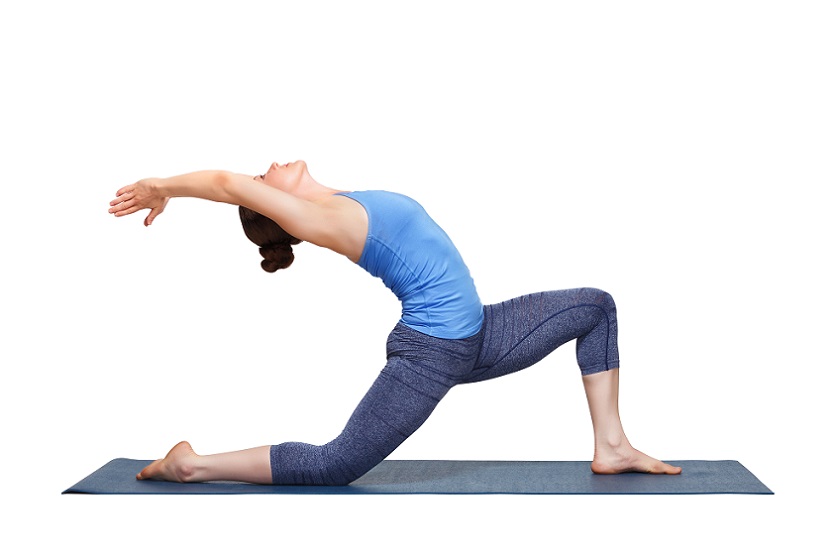
A beginner-intermediate asana, Anjaneyasana or low lunge resembles the common stretch known as the lunge, except it adds an extra energy-boosting element.
Anjaneyasana is performed in a standing position and is a back-bend, stretch, strength and balance-type asana.
It benefits the legs, lats, arms, shoulders, core, hips, pelvis, groin, quads, and opens the chest
Steps:
1. An easy transition to this pose is from downward facing dog pose, in which you bring your right foot forward in between your hands. Furthermore, the right knee is directly over your right ankle.
2. Next, transition the left leg back. As your extend your left leg back, you should feel a stretch in your left thigh and groin. Keep your right leg stationary.
3. From this position, begin to tighten and press your tailbone or buttocks down and forward. This will shift your torso slightly forward as well, giving you a better stretch to the left leg.
4. Then, lift your arms up, either in a prayer position, or stretched over-head at which time, bringing your palms together.
5. Hold the pose for a 5-breath count, continuing to reach your finger tips toward the ceiling.
A Natural Energy Boost!
These four poses are a quick and simple way to use yoga for energy. These yoga postures don’t take up a lot of space and can be done almost anywhere, at any time. This makes them perfect for when you’re sitting in your office, and all your other coworkers are running to grab a cup of coffee to get that after lunch energy boost.
So grab your yoga mat and get started today!
Get updates, top yoga recommendations, and an exclusive preview of our upcoming products!